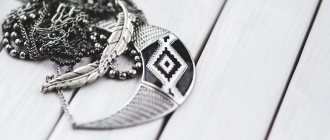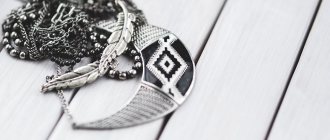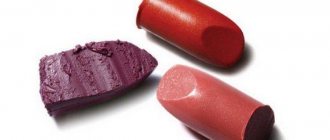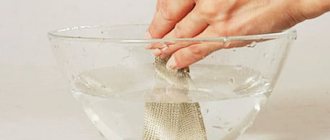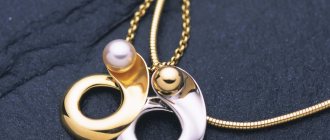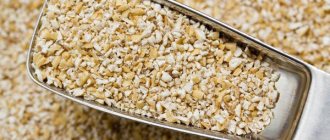Silver is a white noble metal from which a huge amount of jewelry is made every day. Fashion brands in the jewelry industry are always happy to work with silver, since the shiny texture of the metal is very presentable and is also in demand by connoisseurs. Unfortunately, a number of factors can cause silver to yellow. The answer to the question - why does silver turn yellow, contains a whole range of different reasons, but yellowing can be prevented by knowing the prerequisites, and eliminated using effective methods if necessary.
Silver: properties and uses of pure metal. Can silver turn yellow?
It has the entire set of properties that are in demand in medicine. The finest devices are made from silver: for example, 90% of the first generation breathing probes are made of it. If we exclude the aesthetic side of application in the jewelry industry, then we can describe the demand in radio electronics: contacts, wire terminals, transmitter relays and other complex spare parts and parts are made from silver.
Important! In its pure form, argentum exists only in space, where it is not subject to oxidation by oxygen. Pure metal of its original appearance does not turn yellow, since it is inert. But, if the surface of silver has a microscopic layer of patina, then when interacting with a number of elements it will begin to turn yellow.
Why do flowers' leaves turn yellow?
If the edges of the leaves
yellow or brown, this may be due to waterlogging of the soil or lack of watering; too weak or too strong lighting; too high or too low air temperature; excess minerals, dry air or cold draft.
Interesting materials:
How many words in two years? How many words per minute should a second grader read at the end of the school year? How many cm does hair grow in a year? How many dreams a year? How much did bread cost in 1970? How much did bread cost in Russia in 1995? How much did groceries cost in 1980? How much did meat cost in 1980? How much did champagne cost in 1980? How much does an at-home IV cost in 2022?
How to prevent yellowing of silver
There are very effective, and most importantly, time-tested, methods that will help to efficiently clean this metal from the yellow patina. The methods are simple and accessible to every jewelry owner.
Separate storage
It is recommended to store each piece of jewelry separately, preventing them from touching. To do this, it is better to use special polymer ziplock bags. The point is not that decorations influence each other directly. The texture of silver is important. If you place a silver ring on your earrings, a static charge will begin to form between them. In the air, a static charge will begin the microgalvanic process of releasing impurities from the atmosphere. The result will be a small yellow spot where the products touch.
Rules for caring for silver items
Of course, if you take care of your silver items, they will last longer and require less cleaning. And one of the manifestations of such care is proper storage.
- Precious silver should be stored separately from any metals of any kind to prevent their interaction.
- A dry, dark place is ideal for decorations and cutlery. Plus, separate the items into different flannel or cotton or linen bags. Or you can store it in a tightly closed wooden box.
- Wash and clean your silver regularly, once every one or two months.
- Cutlery, when you are not using it, can be wrapped in special paper and stored in a separate cabinet.
- And finally, always remove any jewelry, even earrings, when cleaning the house, using cosmetics or playing sports.
These simple rules for caring for silver items will help you maintain a beautiful shiny look for a long time without effort or spending extra money on special products or the work of a craftsman. Love and care for your silver.
What to do with already yellowed silver: TOP 5 cleaning products
Without a doubt, the best treatment is prevention. But what to do if the silver has already changed color, losing its former luxurious appearance. Cleaning products can be found both in a jewelry store and in your kitchen.
Soap solution
Wash in soapy water
How to remove acid from any thing? That's right, lye! Soap is the most accessible alkali. If you make a soap solution, and then place the decoration, let it “acidify”, then lightly brush it with a brush, you can get rid of the slight deposit.
Important! The method does not work if the yellowness appeared several years ago and is persistently displayed on the jewelry.
Soda and foil
For this method, you need to prepare a sheet of foil, pour in soda, moisten it to form a soda slurry. The decoration is wrapped in foil so that it interacts with the soda. Then, small pieces of foil are used to “scrub” the decoration from any remaining plaque.
Oxidation
Silver turns yellow slowly, but this process still occurs. Jewelers, of course, are aware of this problem, and in order to somehow delay the appearance of yellowness, they came up with the idea of covering silver items with a thin film of rhodium.
This metal is rare and therefore very expensive. The price per troy ounce (31.1 grams) is over $10,000. Previously, rhodium was added to platinum, but later they decided to do rhodium plating on silver.
Rhodium is a metal that, due to its properties, protects silver from entering into a chemical reaction with environmental components. But the rhodium plating wears off over the years. And the jewelry gradually develops first a yellow, then a gray, and finally a black coating.
If it is difficult to remove blackness on your own at home, then anyone can cope with yellowness. You just need to follow our instructions carefully.
Some unusual cleaning methods
Two methods that are available to professionals or residents of certain regions can be considered unusual cleaning methods.
The first method is to make the jewelry an anode (a negatively charged electrode) and place it in an electrolysis solution. Apply a light voltage of 12V through the cathode, which is closed to the anode. The voltage will electrify the anode and cause the yellow oxides to “flake off” and dissolve in the electrolysis.
The second method is ozonation. It is available to jewelry owners who live in mountainous areas. After any thunderstorm or heavy rain, the air is saturated with ozone. For preventative cleaning, simply take all the jewelry out into the air, which is saturated with ozone.
There is another method that should be able to clean silver. If it is a chain or bracelet, then you need to wrap it around a white egg, then put it on the windowsill overnight. By morning the decoration should be new.
Popular beliefs
Progress has forced many of us to abandon superstitions. Perhaps this is correct, but there is no denying that people tried to put deep meaning into signs.
It makes more sense to think of them as a kind of practical advice. You don’t have to assume that something bad will happen to you, but it’s a good idea to think about whether we’re being too careless about ourselves. Often the frantic pace of life gets carried away and we forget about our health and proper nutrition.
Here are a few signs about why silver turns yellow or darkens:
- Has the jewelry that a person wears daily become dark? This is a sign of health problems. Another reason could be damaging it. As soon as a person begins to recover or removes damage, the silver will brighten.
- If household silver utensils begin to turn black, this is a signal that evil spirits have appeared in the home.
However, signs provide only a mystical explanation for this phenomenon. Let's move on to scientifically proven reasons.
Section question - answer
Why did the silver cross turn yellow?
Expert opinion
Pribrezhny Gennady Valentinovich
Jeweler 6th category
The cross may turn black for a number of reasons, but to determine them, you should pay attention to three circumstances: the quality of water consumed during water procedures, health status, and atmospheric air quality. All these circumstances can lead to darkening of silver.
Why did silver turn yellow after cleaning?
Expert opinion
Grishanov Mikhail Petrovich
Jeweler, director of the Grishanov and Co. workshop
Low quality metal turns yellow if it is cleaned with concentrated acid or strong alkalis. Alloys and oxides form compounds with acidic residues, and these are usually yellow or serous in color.
What to do if silver turns yellow?
Expert opinion
Andrey Seleznev
Chemist-technologist, Volgograd
There are a number of effective methods that can be used that can be easily done at home. But it is best to contact professional jewelers who will select an effective method for cleaning yellowed silver.
Reasons for changes
Experts have been able to identify a number of factors that can provoke a change in the color of silver. Basically, the reasons lie in the chemical effect of sulfur and other substances on it:
- Taking medications by a person, using cosmetics, and building materials that contain bromine and iodine. Compounds that form on the surface of a silver item can cause the yellow color to appear. If you don't put the thing in order, then over time it will begin to turn black.
- The presence of sulfur in air masses, which is released from objects made of special rubber. These include clothing, shoes, and furniture fittings.
- A reaction that occurs under the influence of sulfur compounds. Their presence in air masses often leads to the fact that they mix with precipitation, for example rain, forming acids. Their contact with a silver product negatively affects its condition.
- Why does silver on the body turn yellow? The reason for this phenomenon may be the presence of sulfur compounds in surrounding household items: cardboard, wrapping paper, clothing. They do not disintegrate, but after some time begin to be released into the air. When they settle on silver, they provoke the formation of a yellow coating.
- Contact between sulfur and sodium thiosulfate can also change the color of your jewelry. It is the second component that is often present in food industry products. It functions as an oxidizing agent or complexing agent. It can also be used in the textile industry.
- If you are wondering “why does silver turn yellow and what does it mean,” take into account that a significant amount of industrial waste is released into the air every day. They can cause the product to change color.
However, it is not only due to sulfur and its contact with other substances that the color of this noble metal changes. There are a couple more reasons that may also affect this.
- Why does silver on a person turn yellow? The reason sometimes lies in human health problems. Sweat, breathing and other secretions from our body contribute to the formation of yellow plaque.
- Damaged silver is a sign that the product may be of poor quality. There are unscrupulous manufacturers of tableware and jewelry who pass off fake copper and bronze as silver. In order to ensure the authenticity of the metal, it is worth submitting it for examination.
Don't put off cleaning your silver for too long. If you notice a yellow coating on the surface of the product, you need to clean it urgently. Subsequently, it will begin to darken until the metal completely turns black. Then it will be quite difficult to return it to its original appearance, and you risk losing your favorite thing.
Baking soda and aluminum foil
Boil the same half-liter saucepan with 2 tablespoons of soda. Place a strip of food foil in the pan - you can even tear it off the chocolate packaging. Then lower the silver and leave the miracle mixture for 15-20 minutes.
As with copper, the reaction of silver with aluminum is important here, which helps remove any blackness. At the same time, you will forget about cloudiness and layers. The shine will be as good as new! It’s not for nothing that this recipe is the most effective. But it is better to avoid dry soda for cleaning - it is too aggressive an abrasive for soft and delicate silver.
Photo: domstrousam.ru
Options for using enamel
Enamel was used not only as a jewelry material, but also in construction, as it made it possible to decorate architectural structures. For example, at the end of the 19th century. Ovchinnikov produced enameled tiles for covering domes and roofs of buildings in different colors. Enamel increases the strength and fire resistance of the material being coated. In order to obtain colored enamels, metals (lead, cobalt, nickel) were added as oxides, which cause pigmentation. If in Ancient Rus' craftsmen were engaged in independent production of this product. Since the seventeenth century, they have been purchasing enamel imported from Europe, which is of high quality and a variety of colors, which is especially important for the production of jewelry.
Now Russian artists and jewelers are again turning to independent enamel production technologies, since the technical difficulties that jewelers faced in the past do not exist at present. All this becomes possible thanks to the constant development of relations between Russian and Western masters. There are transparent enamels that have a glossy sheen, pure deep color and shimmer against a carved metal background of silver.
Metals used for enameling
Since ancient times, the following metals have been used for jewelry enamels: gold, silver, copper, an alloy of copper and zinc, and extremely rarely bronze.
In the middle of the 19th century. Iron alloys (steel and cast iron) came into practice using enamel. The main requirement for the metal is that its melting point should not be lower than 800°C, i.e. the metal could hold its shape without deforming during the melting and calcination of the enamel itself. In addition to the melting point of the enamel, you must be sure that after application the metal will maintain its natural color and shine, which is especially important when working with transparent enamel. Only precious metals such as gold, silver, and platinum fully possess this property. The rest of the metals oxidize after firing, and their color darkens and becomes duller.
On a silver coating, light blue, dark blue and green enamel options will look especially good. Bronze is considered a poor material for enamel. It oxidizes quickly, but may be suitable for dull opaque enamels. But in this case it can easily crumble.
Source
